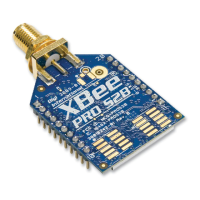Module operation Modes of operation
XBee/XBee-PRO ZigBee RF Modules User Guide 30
Modes of operation
Idle Mode
When not receiving or transmitting data, the RF module is in Idle Mode. The module shifts into the other modes of
operation under the following conditions:
Transmit Mode (serial data in the serial receive buffer is ready to be packetized)
Receive Mode (valid RF data is received through the antenna)
Sleep Mode (End Devices only)
Command Mode (Command Mode sequence is issued)
Transmit Mode
When serial data is received and is ready for packetization, the RF module will exit Idle Mode and attempt to
transmit the data. The destination address determines which node(s) will receive the data.
Prior to transmitting the data, the module ensures that a 16-bit network address and route to the destination
node have been established.
If the destination 16-bit network address is not known, network address discovery will take place. If a route is not
known, route discovery will take place for the purpose of establishing a route to the destination node. If a module
with a matching network address is not discovered, the packet is discarded. The data will be transmitted once a
route is established. If route discovery fails to establish a route, the packet will be discarded. The following
drawing shows the Transmit Mode sequence.
When data is transmitted from one node to another, a network-level acknowledgment is transmitted back across
the established route to the source node. This acknowledgment packet indicates to the source node that the
data packet was received by the destination node. If a network acknowledgment is not received, the source node
will re-transmit the data.
It is possible in rare circumstances for the destination to receive a data packet, but for the source to not receive
the network acknowledgment. In this case, the source will retransmit the data, which could cause the destination

